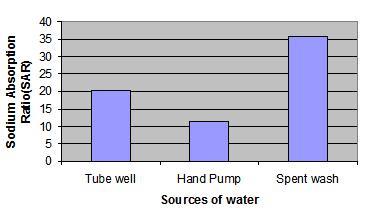
2 minute read
Organic Matter Walky and Black method [31
from Effect of Distillery Spent-wash on Channel Bed and Groundwater Quality: Case Study of Unicol Distill
Bicarbonate (HCO3)
The bicarbonate (HCO3) concentration in groundwater samples collected from different sources was examined and compared with spent wash. The data (Figure 9) indicated that the lowest HCO3 concentration (247.00 ppm) was determined in groundwater samples collected from tube well; and the HCO3 concentration in hand pump water was 430.00 ppm; while the highest HCO3 concentration (6166.70 ppm) was determined in spent wash. The above data on HCO3 concentrations in analyzed water and spent wash samples showed a highly significant difference and concluded that the HCO3 concentration in spent wash samples was exceptionally higher than the water samples regardless the source of water. Moreover, differences in bicarbonate concentration between tube well and hand pump waters was also significant (P<0.05) showing that bicarbonate concentration in deep waters is lesser than the shallow waters.
Advertisement
Fig.9: Groundwater analysis for HCO3 obtained from different water sources as compared to spent wash channel bed
Chloride (Cl)
The Chloride (Cl) content in groundwater samples collected from hand pumps and tube wells in surrounding areas of spent wash channel bed was determined and compared with chloride content of spent wash. The data (Figure 10) showed that the lowest chloride content (2117 ppm) was found in groundwater samples collected from hand pump; and the chloride content in tube well water was more than double to that of hand pump water (5259 ppm); while the highest chloride content (14097 ppm) was found in spent wash. This suggested that chloride quantities in spent wash are extraordinarily higher than the groundwater regardless the source of water. The differences in Chloride content between tube well and hand pump waters was also significant (P<0.05) indicated that the chloride content was higher in deep waters than the shallow waters.

Fig.10: Groundwater analysis for Cl (ppm) obtained from different water sources as compared to spent wash channel bed
Electrical conductivity (EC)
The electrical conductivity (EC) level of groundwater samples collected from various sources such as tube well and hand pumps was determined and compared with spent wash. The data (Figure 11) indicated that the lowest EC level (11.077 dS m-1) was determined in groundwater samples collected from hand pumps; and the EC level in tube well water was relatively higher (17.262 dS m-1); while the alarmingly highest EC level (47.090 dS m-1) was determined in spent wash. This indicates that deep waters are of higher electrical conductivity as compared to that of shallow waters of hand pumps. However, spent wash was of huge level of electrical conductivity when compared with ground water irrespective of the source of water.

Fig.11: Groundwater analysis for EC (dS/m) obtained from different water sources as compared to spent wash channel bed






